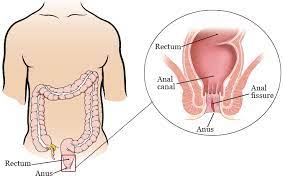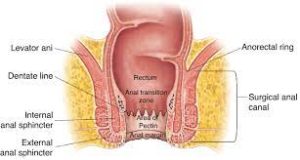
 The anal canal is the part that connects the rectum to the anus, located below the level of the pelvic diaphragm.
The anal canal is the part that connects the rectum to the anus, located below the level of the pelvic diaphragm.
The anal region is comprised of the anal canal, and the perianal region, with the anal canal the more proximal portion of the anal region.
The anal canal is located within the anal triangle of the perineum, between the right and left ischioanal fossa.
The anal canal is final functioning segment of the bowel.
The anal canal functions to regulate release of excrement by two muscular sphincter complexes.
The anal canal is defined by the sphincter muscles.
The anus is the opening at the terminal portion of the anal canal.
Anal canal is approximately 2.5 to 4 cm (0.98 to 1.57 in) long, from the anorectal junction to the anus.
The anal canal directs downwards and backward, and is surrounded by inner involuntary and outer voluntary sphincters which keep the lumen closed in the form of an anteroposterior slit.
The anal canal is differentiated from the rectum by a transition along the internal surface from endodermal to skin-like ectodermal tissue.
The anal canal is divided into two segments: an upper and lower, separated by the pectinate line/dentate line.
The mucosal lining of the anal canal is predominantly formed by squamous epithelium.
The anal verge refers to the distal end of the anal canal, a transitional zone between the epithelium of the anal canal and the perianal skin.
The anatomic anal canal begins at the anorectal ring, and extends to the anal verge at the squamous mucocutaneous junction with the perianal skin.
The anal gland secretes lymph discharge and built-up fecal matter from the colon lining.
The external anal sphincter muscle is the voluntary muscle that surrounds and adheres to the anus.
The external anal sphincter muscle is at the lower margin of the anal canal.
This muscle is in a state of tonic contraction.
During defecation, the external anal sphincter muscle relaxes to allow the release of feces.
Fecal movement is also controlled by the involuntarily controlled internal anal sphincter, which is an extension of the circular muscle surrounding the anal canal. It relaxes to expel feces from the rectum and anal canal.
